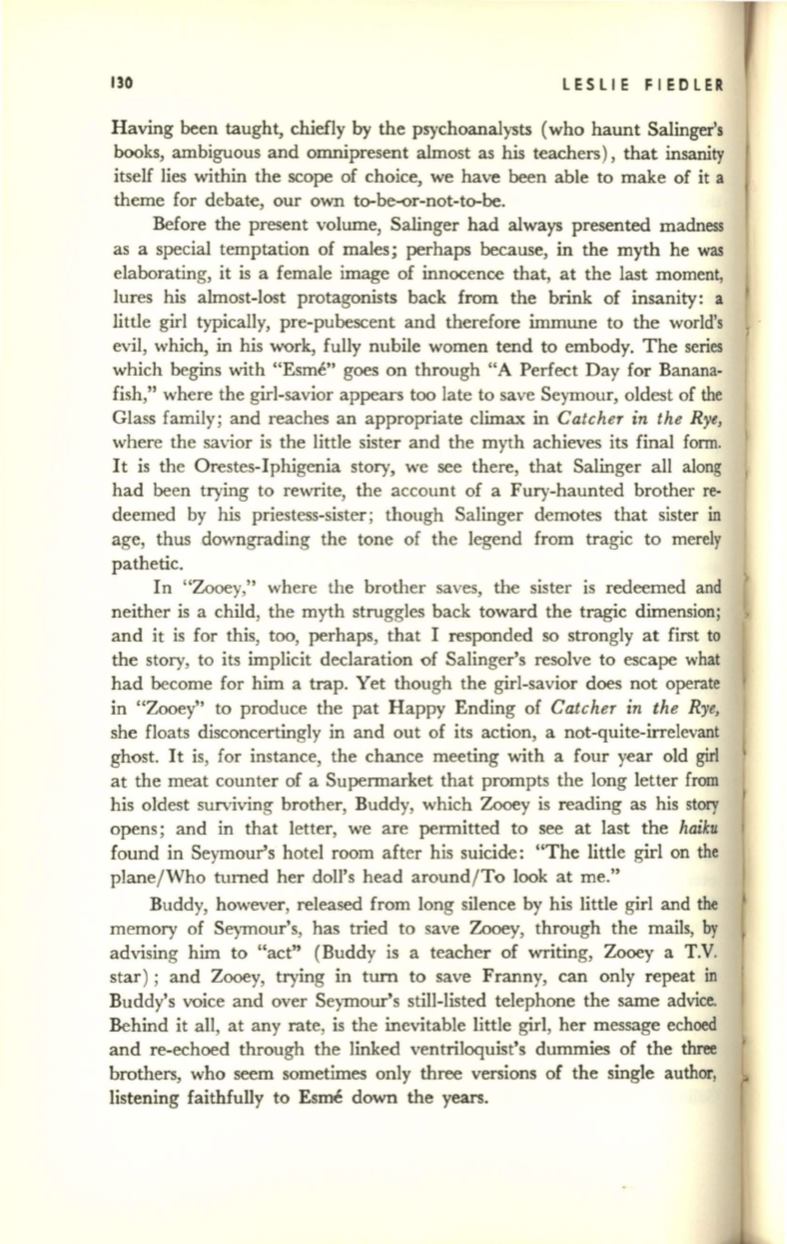
130
LESLIE FIEDLER
Having been taught, chiefly by the psychoanalysts (who haunt Salinger's
books, ambiguous and omnipresent almost as his teachers), that insanity
itself lies within the scope of choice, we have been able to make of it a
theme for debate, our own to-be-or-not-to-be.
Before the present volume, Salinger had always presented madness
as a special temptation of males; perhaps because, in the myth he was
elaborating, it is a female image of innocence that, at the last moment,
lures his almost-lost protagonists back from the brink of insanity: a
little girl typically, pre-pubescent and therefore immune to the world's
evil, which, in his work, fully nubile women tend to embody. The series
which begins with "Esme" goes on through "A Perfect Day for Banana–
fish," where the girl-savior appears too late to save Seymour, oldest of the
Glass family; and reaches an appropriate climax in
Catcher in the
Rye,
where the savior is the little sister and the myth achieves its final form.
It is the Orestes-Iphigenia story, we see there, that Salinger all along
had been trying to rewrite, the account of a Fury-haunted brother re–
deemed by his priestess-sister; though Salinger demotes that sister
in
age, thus downgrading the tone of the legend from tragic to merely
pathetic.
In "Zooey," where the brother saves, the sister is redeemed and
neither is a child, the myth struggles back toward the tragic dimension;
and it is for this, too, perhaps, that I responded so strongly at first to
the story, to its implicit declaration of Salinger's resolve to escape what
had become for him a trap. Yet though the girl-savior does not operate
in "Zooey" to produce the pat Happy Ending of
Catcher in the
Rye,
she floats disconcertingly in and out of its action, a not-quite-irrelevant
ghost.
It
is, for instance, the chance meeting with a four year old
girl
at the meat counter of a Supermarket that prompts the long letter from
his oldest surviving brother, Buddy, which Zooey is reading as his story
opens; and in that letter, we are permitted to see at last the
haiku
found in Seymour's hotel room after his suicide: "The little girl on the
plane/Who turned her doll's head around/To look at me."
Buddy, however, released from long silence by his little girl and the
memory of Seymour's, has tried to save Zooey, through the mails, by
advising him to "act" (Buddy is a teacher of writing, Zooey a T.v.
star); and Zooey, trying in turn to save Franny, can only repeat in
Buddy's voice and over Seymour's still-listed telephone the same advice.
Behind it all, at any rate, is the inevitable little girl, her message echoed
and re-echoed through the linked ventriloquist's dummies of the three
brothers, who seem sometimes only three versions of the single author,
listening faithfully to Esme down the years.


